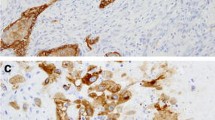Abstract
Pulmonary pleomorphic carcinoma is an uncommon malignant tumor of the lung, which has the dual cell components of spindle or giant cells and epithelial cells. The objective of this study was to investigate the clinical course and efficacy of palliative chemotherapy in patients with advanced pulmonary pleomorphic carcinoma. Twelve patients were diagnosed with advanced pulmonary pleomorphic carcinoma and received palliative chemotherapy from February 2000 to December 2007. Among the 12 patients, five patients received gemcitabine/cisplatin, three patients received gemcitabine/carboplatin, two patients received paclitaxel/carboplatin, one patient received paclitaxel/cisplatin, and one patient received docetaxel/cisplatin as first-line chemotherapy. The median patient's age was 62 (range, 32–72 years). Among the 12 patients, nine patients had relapsed disease after curative resection and three patients had metastatic disease at the initial presentation. After treatment with first-line palliative chemotherapy, seven patients (58%) had progressive disease, three patients (25%) had stable disease, and only two patients (17%) had a partial response. The median overall survival from the day of initiation of first-line chemotherapy was only 8 months (95% CI, 6–10) with median follow-up of 26 months. These results showed the dismal prognosis and the poor response to chemotherapy of advanced pulmonary pleomorphic carcinoma. Further studies are needed to investigate whether the current strategy of palliative chemotherapy for the treatment of advanced pulmonary pleomorphic carcinoma can be justified or not. Moreover, additional novel treatment approaches are required.

Similar content being viewed by others
References
Beasley MB, Brambilla E, Travis WD. The 2004 World Health Organization classification of lung tumors. Semin Roentgenol. 2005;40:90–7. doi:10.1053/j.ro.2005.01.001.
Brambilla E, Travis WD, Colby TV, Corrin B, Shimosato Y. The new World Health Organization classification of lung tumours. Eur Respir J. 2001;18:1059–68. doi:10.1183/09031936.01.00275301.
Fishback NF, et al. Pleomorphic (spindle/giant cell) carcinoma of the lung. A clinicopathologic correlation of 78 cases. Cancer. 1994;73:2936–45. doi:10.1002/1097-0142(19940615)73:12<2936::AID-CNCR2820731210>3.0.CO;2-U.
Travis WD. Pathology of lung cancer. Clin Chest Med. 2002;23:65–81, viii. doi:10.1016/S0272-5231(03)00061-3.
Raveglia F, et al. Personal experience in surgical management of pulmonary pleomorphic carcinoma. Ann Thorac Surg. 2004;78:1742–7. doi:10.1016/j.athoracsur.2004.04.084.
Chang YL, Lee YC, Shih JY, Wu CT. Pulmonary pleomorphic (spindle) cell carcinoma: peculiar clinicopathologic manifestations different from ordinary non-small cell carcinoma. Lung Cancer. 2001;34:91–7. doi:10.1016/S0169-5002(01)00224-0.
Bae HM, et al. Palliative chemotherapy for pulmonary pleomorphic carcinoma. Lung Cancer. 2007;58:112–5. doi:10.1016/j.lungcan.2007.05.006.
Aketa A, et al. Two younger male patients with rapidly progressing pulmonary pleomorphic carcinoma. Nihon Kokyuki Gakkai Zasshi. 2004;42:164–9.
Segawa M, Kusajima Y, Saito K. Pleomorphic carcinoma of the lung rapidly developed multiple metastases after surgery. Kyobu Geka. 2006;59:387–91.
Yuki T, et al. Pleomorphic carcinoma of the lung: a surgical outcome. J Thorac Cardiovasc Surg. 2007;134:399–404. doi:10.1016/j.jtcvs.2007.04.018.
Tamura M, et al. Pulmonary pleomorphic carcinoma; report of 2 cases. Kyobu Geka. 2006;59:585–9.
Rossi G, et al. Pulmonary carcinomas with pleomorphic, sarcomatoid, or sarcomatous elements: a clinicopathologic and immunohistochemical study of 75 cases. Am J Surg Pathol. 2003;27:311–24. doi:10.1097/00000478-200303000-00004.
Kim TH, et al. Pleomorphic carcinoma of lung: comparison of CT features and pathologic findings. Radiology. 2004;232:554–9. doi:10.1148/radiol.2322031201.
Okada M, et al. Evolution of surgical outcomes for nonsmall cell lung cancer: time trends in 1465 consecutive patients undergoing complete resection. Ann Thorac Surg. 2004;77:1926–30. discussion 31. doi:10.1016/j.athoracsur.2004.01.002.
Author information
Authors and Affiliations
Corresponding author
Rights and permissions
About this article
Cite this article
Hong, J.Y., Choi, M.K., Uhm, J.E. et al. The role of palliative chemotherapy for advanced pulmonary pleomorphic carcinoma. Med Oncol 26, 287–291 (2009). https://doi.org/10.1007/s12032-008-9117-4
Received:
Accepted:
Published:
Issue Date:
DOI: https://doi.org/10.1007/s12032-008-9117-4




